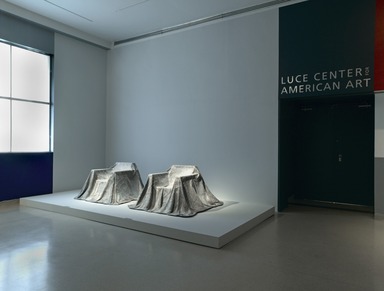
Stalin Chairs (installation)
DATES February 14, 2007 through June 17, 2007
ORGANIZING DEPARTMENT
Contemporary Art
COLLECTIONS
Contemporary Art
-
Robert Wilson was born in Waco, Texas, attended the University of Texas and studied architecture and design at Pratt Institute in Brooklyn. He achieved international acclaim in 1971 for Deafman Glance, a seven-hour silent stage work. In the years that followed, his name became synonymous with experimental theater around the world.
A self-proclaimed “fine artist who works in theater,” Wilson not only produces performances but also designs the sets for all of his productions. He envisions the props as sculptural elements that complement and contextualize the performances. A signature work is Stalin Chairs, which appeared in Wilson’s The Life and Times of Joseph Stalin (1973), staged (like many of his other works) at the Brooklyn Academy of Music. To create these objects, Wilson coated armchairs with a layer of resin and then draped them with thin, crumpled sheets of lead. The use of such a heavy, toxic metal subverts the inherent function of the chairs as objects of comfort, rendering them enigmatic and sinister. This covering also refers to the practice of shrouding the furniture of noble estates to protect it during residents’ lengthy absences.
The idea of two identical chairs reflects the fact that Stalin possessed two identical apartments, each furnished with two armchairs draped in fabric. Wilson’s chairs have an imposing physical presence yet signify the absence of the person who would use them, just as Stalin himself, long after his death, remained a major presence in Russian political history, despite his physical absence.
The Museum is honored to showcase this multifaceted work by a longtime Brooklyn artist. Stalin Chairs is part of our borough’s cultural history.
